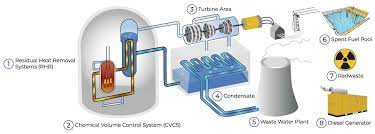- The fourth unit of the Kakrapar Atomic Power Project (KAPP) in Gujarat started controlled fission chain reaction and thus became critical at 1.17 a.m. on Sunday. Kakrapar is about 80 km from Surat.
- The project’s units with a capacity of 700 MWe each are the largest indigenous nuclear power reactors to be built by Nuclear Power Corporation of India Ltd. (NPCIL).
- KAPP-3 is the country’s first 700 MWe (megawatt electric) unit, and the biggest indigenously developed variant of the Pressurised Heavy Water Reactor (PHWR).
- PFBR is a 500 MWe fast breeder nuclear reactor presently being constructed at the Madras Atomic Power Station in Kalpakkam (Tamil Nadu).
About Pressurized Heavy Water Reactor:
- PHWR technology was introduced in India in the late 1960s with the construction of RAPS-1, a CANDU reactor in Rajasthan.
- It is a nuclear power reactor, commonly using unenriched natural uranium as its fuel, that uses heavy water (deuterium oxide D2O) as its coolant and moderator. WHR, enrichment of Uranium to improve concentration of U-235 is not required.
- U-238 can be directly fed into the reactor core.
- PHWRs was a natural choice for implementing the first stage because it had the most efficient reactor design in terms of uranium utilization.
- The use of heavy water as the moderator is the key to the PHWR (pressurized heavy water reactor) system, enabling the use of natural uranium as the fuel (in the form of ceramic UO2), which means that it can be operated without expensive uranium enrichment facilities.

